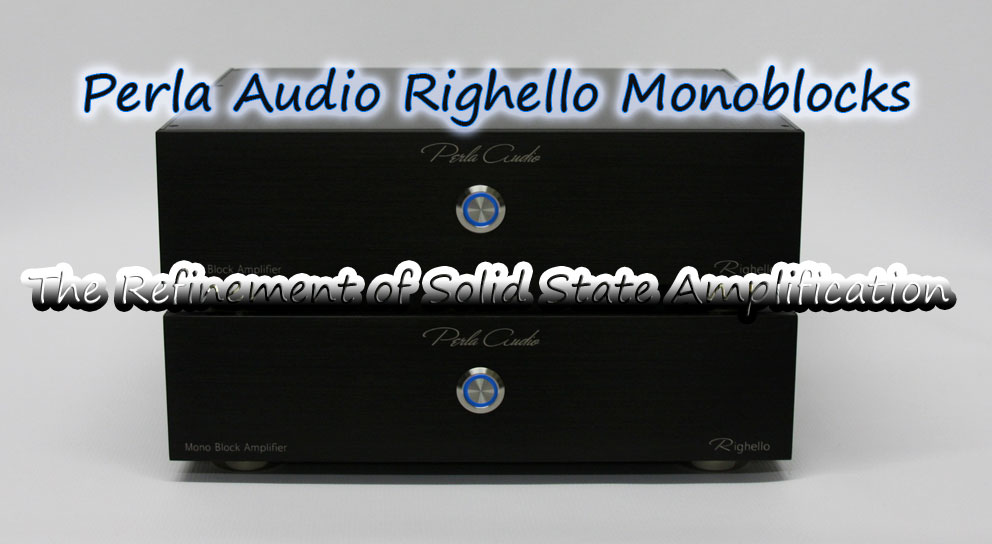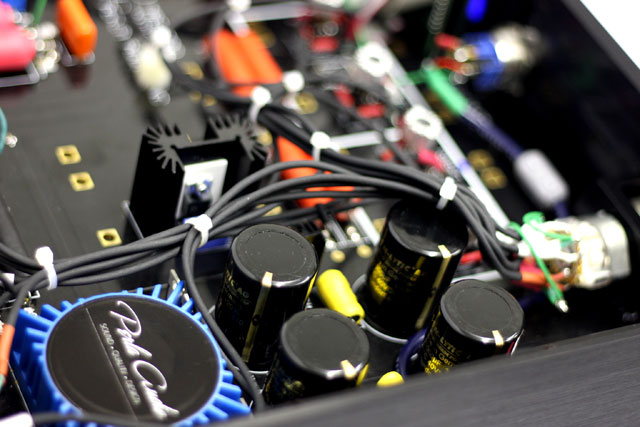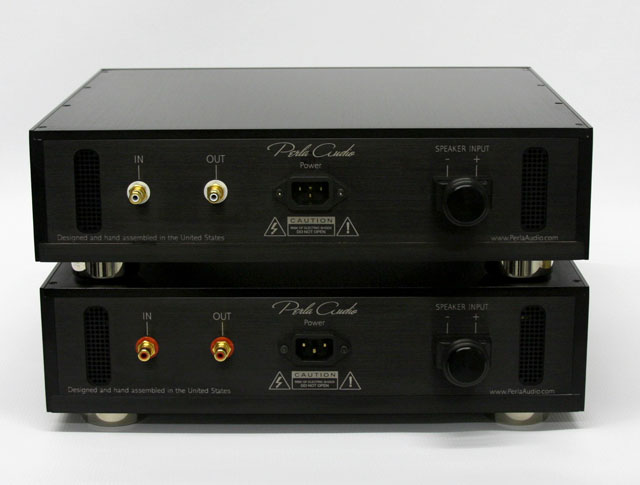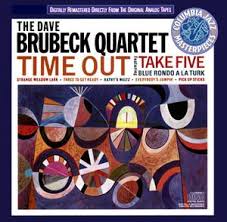Perla Audio Righello Monoblocks

 I first learned of Perla Audio in Don Schaulis’ Stereotimes 2016 T.H.E Show Newport Beach report and have since learned the Perla Audio received an Absolute Sound Editors’ Choice award. I was stoked by the enthusiasm and passion displayed Shane Duffy, owner, during our first phone conversation while discussing the various aspects of Perla Audio’s design principles.
I first learned of Perla Audio in Don Schaulis’ Stereotimes 2016 T.H.E Show Newport Beach report and have since learned the Perla Audio received an Absolute Sound Editors’ Choice award. I was stoked by the enthusiasm and passion displayed Shane Duffy, owner, during our first phone conversation while discussing the various aspects of Perla Audio’s design principles.
Perla Audio, a family owned business located in Sparks, Nevada, became a player in the high end audio scene back in 2012. Perla Audio came about in 2010 when Duffy was finalizing one of his loudspeaker designs and realized he needed someone with more experience to help refine the design. In 2011, he met Ronald Van Robinson, who had admired many renowned designers such as Dave Wilson, Alon Wolf, and the late Ken Shindo, and wished to design similar statement products for the high-end market. Sharing the same goals to produce no comprise statement products, Robinson and Duffy, joined forces to form Perla Audio.
In my discussions with Duffy, Perla Audio aims to design and manufacture the finest audio components as founded by the following principles: “Always put the purity of sound foremost, never compromise the quality of components and let the appeal of design be complementary.” According to Duffy, “It takes passion, skill, and decades of searching for the highest quality parts and most sophisticated circuits.” Chief engineer, Ronald Van Robinson, has more than thirty years of experience in designing and engineering tube and solid-state amplifiers, ribbon and monitor loudspeakers, as well as source components such as digital-to-analog converters and phonostages. The basis of Ron’s designs is now Perla Audio.
The many unique characteristics of the Righello monoblock amplifier design can be summarized as follows:

• 100 watts into 8 ohms and 200 watts into 4 Ohms.
• Frequency response of DC to 100 kHz
• 27 dB voltage gain.
• Zero negative feedback running in Class A/B.
• Push/pull output and driver stages.
• Single-ended input voltage gain.
• No capacitors in the signal path.
• Power supply capacitance of over 178k μf consisting of high-quality electrolytic capacitors & 40 polypropylene capacitors
• Fully ‘PI’ filtered in its AC and DC filters for ultra-low noise.
• 100K Ohm input impedance.
• It uses 2 quantum noise filters in the DC supplies. It uses a 4x bridge rectifier quadrupling the schottky diodes in the bridges and 4 shielded toroidal power transformers in parallel.
• One output for subwoofer or auxiliary out.
• CNC machined chassis from solid billets of aluminum with a black anodized finish.
• Custom made 3.35 mm thick 2 Oz copper 24k gold-plated PCB boards.
• All components are hand soldered using Cardas Audio ultra-pure quad eutectic solder containing a proprietary blend of silver, copper, tin & lead.
• < 5 watts of power is used at standby.
Anyone that has come over to listen to the Righello monoblock amplifier immediately notices the build quality of this amplifier. After extensive examination of the exterior and interior chassis, it was clearly evident to me that the exterior finish and interior assembly exudes a special attention to quality. I was also impressed by the thermal management of this design by the lack of external heatsinks for cooling and the design approach of the power supply.

Another really cool thing about the Perla I learned in my discussions with Shane Duffy …is it’s modifiable design. One doesn’t have to worry about having the latest product offerings from Perla Audio. Existing units can be sent back and updated to later revisions. I’m told that any updates can be retrofited by Perla Audio at “reasonable” prices. Since I’m on my third generation of the Ayon Audio Triton which has been quite costly, the Perla upgrade path is a welcomed departure from the high end audio upgrade circus.
My First Experience with Solid State Monoblocks
My reviewing system includes the Ayon Audio S-5 Network Player, Laufer Teknik Memory Player 64, Pioneer bdp-09fd Blu-Ray player, Ayon Audio Triton MKIII integrated amplifier fitted with Shuguang Treasure KT-120 power tubes and Radiotechnique signal tubes, Acoustic Zen Crescendo loudspeakers, REL R-528SE subwoofer, SR Atmosphere Level 4 speaker cables and interconnects, SR Tesla LE REL SPEC Subwoofer Reference cable, SR UEF power cords, SR PowerCell 12 UEF, SR Tesla Plex SE outlets, SR HFTs, SR Atmosphere XL, FEQs, SR UEF XOTs, SR UEF power cable tuning circuits, SR Grounding Block and HDG cables, SR Black Box, SR MiGs and SR Tranquility Bases UEF. As for my listening area, its 14.5’ wide, has a 9’ ceiling, and has an open back wall to 1500 sq ft of first floor living area.
 For this review, I disconnected all interconnects and power cords plugged into my Ayon Audio Triton MKIII integrated amplifier and swapped in both Perla Audio Righello monoblock amplifiers which I vertically stacked on one SR Tranquility Bases UEF and mechanically isolated by a set of SR MIGs 2.0. Listening only to tube based amplification for the last 5 years, my first impressions were unexpected. Tonally, the Righello monoblock was very similar in the midrange and higher frequencies to my reference Ayon Audio Triton MKIII integrated tube amplifier player in triode mode but in contrast, the bass frequencies had much greater authority and extended range with the Righello monoblocks in my system. The foundation, extension, and dynamic driver in the lower and mid bass frequencies eliminated the need for my REL subwoofer which has never happened before. Listening to the middle of Take Five from the album The Dave Brubeck Quartet – Take Five confirmed to me how well these monoblocks resolved the lower and mid bass frequencies while maintaining realistic dynamics.
For this review, I disconnected all interconnects and power cords plugged into my Ayon Audio Triton MKIII integrated amplifier and swapped in both Perla Audio Righello monoblock amplifiers which I vertically stacked on one SR Tranquility Bases UEF and mechanically isolated by a set of SR MIGs 2.0. Listening only to tube based amplification for the last 5 years, my first impressions were unexpected. Tonally, the Righello monoblock was very similar in the midrange and higher frequencies to my reference Ayon Audio Triton MKIII integrated tube amplifier player in triode mode but in contrast, the bass frequencies had much greater authority and extended range with the Righello monoblocks in my system. The foundation, extension, and dynamic driver in the lower and mid bass frequencies eliminated the need for my REL subwoofer which has never happened before. Listening to the middle of Take Five from the album The Dave Brubeck Quartet – Take Five confirmed to me how well these monoblocks resolved the lower and mid bass frequencies while maintaining realistic dynamics.
 I wouldn’t go as far as to say that the Righello monoblocks have that distinctive liquidity and harmonic richness that only tube amplifier possesses but it did have a warm, smooth, and natural sounding presentation that was just as enjoyable. What really struck me from the first note played was how holographic these monoblocks were with images completely detached from my AZ Crescendo loudspeakers. Holographic is a term rarely used when describing solid state amplification but the imaging of the vocals, guitar, piano, and electric keyboard on the eighth cut, Bluebird and the tenth cut, Red Ant (Nature) elevated my perception of the 3D soundstage on the 24 bit /96k Hz hirez download of Neighborhoods by Olu Dara.
I wouldn’t go as far as to say that the Righello monoblocks have that distinctive liquidity and harmonic richness that only tube amplifier possesses but it did have a warm, smooth, and natural sounding presentation that was just as enjoyable. What really struck me from the first note played was how holographic these monoblocks were with images completely detached from my AZ Crescendo loudspeakers. Holographic is a term rarely used when describing solid state amplification but the imaging of the vocals, guitar, piano, and electric keyboard on the eighth cut, Bluebird and the tenth cut, Red Ant (Nature) elevated my perception of the 3D soundstage on the 24 bit /96k Hz hirez download of Neighborhoods by Olu Dara.
Over the course of this review, I swapped in both digital sources (Ayon Audio S-5 Network Player, Laufer Teknik Memory Player 64) and based on the transparency of the Righello monoblocks, it was always easy to perceive the soundscape changes (up front and center vs. the back row of the venue) as displayed by each digital source. To me this proved that the Righello monoblocks performed solely to amplifier the input signal without adding its own flavor which is one of its greatest strengths.

Mike Girardi
Specifications
Power : 100 watt 8 Ohm 200 watt 4 Ohm
Frequency Response : DC to 100 kHz
Power Consumption at Standby : < 5 watts
Input impedance : 100K
Voltage gain : 27 dB
Height : 5” 5/8 with feet
Width : 14” ½
Length : 18”
Price: Righello monoblock amplifier: $12,900/pair
Website: www.perlaaudio.com
Phone numbers: (775) 722-1488
Stereo Times Masthead
Publisher/Founder
Clement Perry
Editor
Dave Thomas
Senior Editors
Frank Alles, Mike Girardi, Russell Lichter, Terry London, Moreno Mitchell, Paul Szabady, Bill Wells, Mike Wright, and Stephen Yan,
Current Contributors
David Abramson, Tim Barrall, Dave Allison, Ron Cook, Lewis Dardick, John Hoffman, Dan Secula, Don Shaulis, Greg Simmons, Eric Teh, Greg Voth, Richard Willie, Ed Van Winkle, Rob Dockery, Richard Doran, and Daveed Turek
Site Management Clement Perry
Ad Designer: Martin Perry





Be the first to comment on: Perla Audio Righello Monoblocks